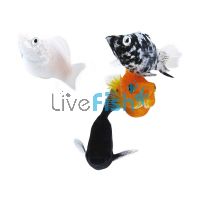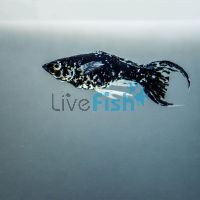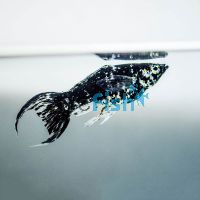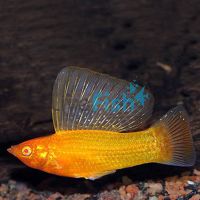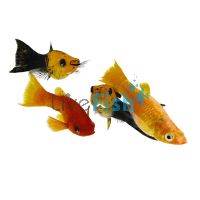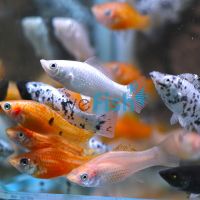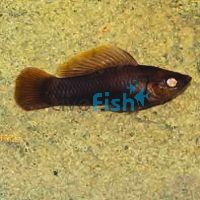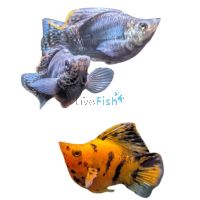They are also prolific live breeders, making them a great intro species if you want to get into breeding as a hobby. Mollies have only slight variations in size and body shape, with the most dramatic outlier being the Sailfin mollies, which feature a very pronounced dorsal fin reminiscent of a tiny sailfish.
Molly Care
Mollies are fairly low maintenance and are capable of tolerating a fairly wide range of water parameters, which makes them a great inclusion for a fish tank setup for beginners. One hurdle you may find with mollies is their propensity for disease, so it is very important to follow quarantine rules before introducing mollies to your main tank.
It’s also worth being prepared for possible outbreaks of the more common sicknesses by having some treatment medications on hand. Including some classic Black Mollies in your community tank makes it very easy to detect any white spot outbreaks which can be easily treated with a white spot remedy.
A properly cared for molly has a lifespan of about 5 years with a maximum length of 15 cm (6”), though it is extremely rare to see a molly of this size. As a shoaling fish, it is recommended to keep a minimum of four mollies in a tank with the majority being female to help reduce the risk of aggression. Some of our most popular mollies include the Dalmatian Molly, Black Lyretail Molly, Silver Molly and our great value assorted Balloon molly packs.
It is common for Mollies to interbreed between the different species so if you have a few different types expect many variations to appear in your tank as they reproduce.
Natural Habitat
Mollies are found in the wild in the southern parts of the USA, through Central America and the northern parts of South America. They are particularly prolific in Mexico and prefer slower-moving streams, rivers and even brackish water.

Behavior/Compatibility for Mollies
Mollies have a fairly friendly temperament but may get into some fin nipping habits on occasion. It is best to avoid mixing male mollies with species featuring large, flowing fins such as fancy goldfish and Angelfish. A larger tank may help in curbing this behaviour. Groups with predominantly male mollies have also been known to harass female mollies, so keeping 2 or 3 females to each male ratio is recommended. Mollies are a mid-water to surface level fish and they spend most of their time out in the open. As a shoaling fish, you will usually see them exploring the tanks in groups as younger fish before gaining more independence with maturity. Some of the better tankmates for mollies include Danios, peaceful Barb varieties, Tetras and Corydoras.
Housing Mollies and Aquarium Fish Tank Set-up Tips
Tank
While mollies are relatively small fish, they are very active and will require a slightly larger tank for their size. They are also highly sociable fish and should be kept in groups of at least four mollies. While the maximum size you will ever see in mollies is 15 cm (6”), most variations will reach half this size, while dwarf mollies will reach only 3 cm (1.2”) in size. For this section we will focus on the general 7 cm (3”) molly variations, so please be sure you consider the needs for the larger Sailfin mollies should you wish to keep them. Being an active fusiform fish, longer tanks are preferred over tall for mollies.
Recommended Max Fish Count Tank Volume 4 Mollies 45 litres (12 gallons) 8 Mollies 68 litres (18 gallons) 12 Mollies 92 litres (26 gallons) 15 Mollies 128 litres (34 gallons) Base
Despite being a more mid-water swimmer, mollies often enjoy diving down to the depths of the tank to hang out in the roots of plants or under overhangs. For this reason, a soft sand substrate is best in order to avoid errant bumps and scrapes, particularly with Sailfin Mollies.
Foliage
Although mollies spend most of their time out in the open, offering a few fish tank decorations with hiding spots are recommended. Thicker live or plastic plants, driftwood with overhangs or other decorations featuring caves and swim-throughs are recommended to keep your mollies happy, avoid aggression, and will actually encourage them to swim in the open more often.
Water
A fairly hardy fish, mollies will tolerate a range of water conditions. While mollies can be found in brackish water, you should not need to increase the salinity of your water. Fish that were raised in water with higher salt levels may struggle in freshwater, though none of our mollies will require this. Mollies enjoy temperatures of 22 to 30 degrees C (71 – 85 F). Depending on your local climate, you may need to install a water heater to ensure the temperature stays within this range.
You should aim for a Ph of 5.5-8 and a hardness of 1-15 DGH. To ensure your pH and hardness are suitable you should invest in a testing kit. Always ensure your water is properly filtered, and regularly change the water (10% weekly or 25% every other week). You should also filter the substrate regularly and adjust the chemistry of any tap water you use to top your tank. You may do this with one of our many water conditioning products.
Feeding and Care
An omnivorous fish, mollies should be fed both meat and plant matter, with a bias toward meat. As a surface feeder, high-quality flakes are a great staple but should be paired with semi-regular live or frozen brine shrimp, bloodworms or daphnia. Lettuce, zucchini and cucumber should also be offered to balance out their diets, but be sure not to overfeed. Please see our wide selection of fish food options to find something suitable for your mollies.
Great reasons to keep Mollies in your tropical fish tank
- • They are highly active fish that will add life and colour to your community tank.
- • Mollies are an excellent intro to fish breeding.
- • They are an easy fish to keep happy and allow a lot of wiggle room for you to cater for your more fussy species’ needs.
See below for our wide range of mollies and select your favourite variety, will you go for larger Sailfin Mollies or a smaller Balloon Molly? You pick em, we’ll ship em!
